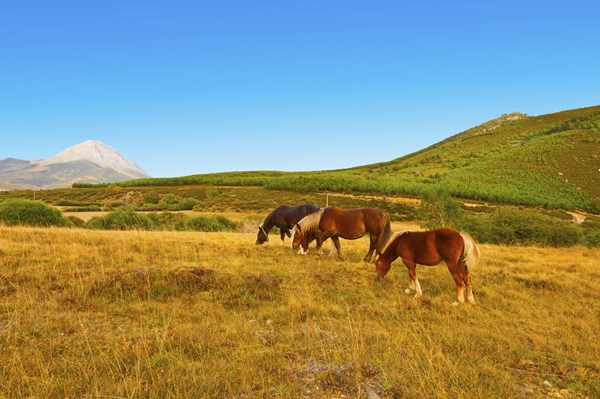
Shorter days and colder temperatures can only mean one thing: Autumn has arrived, and winter is close behind. For horses, this means that the lush pasture they enjoyed munching on in the warm sunshine will now be replaced by hay. For horse owners, it means making sure that the transition from pasture to hay is a healthy one.
“When winter arrives, horses must be in good condition to withstand colder temperatures,” said Karen E. Davison, PhD, equine sales and support manager, Purina Animal Nutrition. “There are a number of steps horse owners can take to help their horses move into fall and winter in good health, and emerge in the spring the same way.”
Davison shares these five tips to help ensure a smooth transition from pasture to hay, and to formulate a sound fall and winter feeding plan.
1. Gauge grain rations. Fall is an important time to evaluate the quality of forage available for your horse and whether the grain ration is appropriate and adequate to meet nutritional requirements. Hay and pasture generally don’t provide the same level of nutrition. To ensure your horse remains in good condition throughout the cold-weather months, evaluate and adjust grain rations in the early fall to prevent weight loss due to lower-quality forage. If your horse needs to gain weight, there is still time to do so before the really cold weather sets in.
2. Avoid late-fall gorging. While the sugars produced by pasture plants are used to fuel their growth in warm temperatures, colder fall nights hinder growth and sugars are stored for later use. This concentration of stored sugars may increase the risk of digestive upset or laminitis in some horses. Horses most at risk are those that are significantly overweight or have trouble managing normal blood sugar levels and are sensitive to dietary sugar content.
3. Guard against colic. Drastic swings in temperature and changing weather conditions–combined with the major adjustment of moving from pasture to hay–can increase the chances of digestive issues. While not scientifically proven, a number of horse owners and veterinarians have experienced what appears to be an association between weather events such as changes in barometric pressure or dramatic fluctuations in ambient temperatures and incidence of colic in horses.
“A dramatic drop in temperature often causes horses to drink less water and, at the same time, horse owners will often increase the amount of hay fed to help their horse stay warm,” said Davison. “More hay and less water consumption may contribute to impaction colic. Always provide clean, tepid water and add a couple ounces of loose salt with the feed ration to encourage water consumption during cold spells.”
4. Take it slow. Switching from pasture to hay or even just getting a new supply of hay represent as big a change to your horse’s digestive system as a change in grain. As with any dietary adjustment, make the changeover from pasture to hay gradually to decrease the risk of digestive upset.
5. Ensure hay quality. Horses should be fed consistent, good-quality hay to maximize nutrition and minimize the potential for digestive problems. Good-quality hay should:
- have a high leaf-to-stem-ratio,
- be free of weeds, dirt, molds and other contamination,
- have small-diameter stems,
- contain few seed heads or blooms,
- have a fresh smell and appearance,
- be a bright color (a faded, yellow or brown color may indicate old hay or poor storage conditions).
Plant maturity is the main factor in hay quality: Young, leafy, immature plants contain more protein, energy and minerals than older plants with thicker stems. Mature plants also contain more lignin, which reduces nutrient availability. Supplement lower-quality hay with higher-quality feed to maintain your horse’s good condition and health.
Keeping your horse warm, well-fed and adequately watered during cold weather will help ensure he will be healthy and ready to go when spring rolls around–hopefully sooner rather than later.
For more information on horse health and nutrition visit purinamills.com/horse-feed.
Purina Animal Nutrition LLC (www.purinamills.com) is a national organization serving producers, animal owners and their families through more than 4,700 local cooperatives, independent dealers and other large retailers throughout the United States. Driven by an uncompromising commitment to animal excellence, Purina Animal Nutrition is an industry-leading innovator offering a valued portfolio of complete feeds, supplements, premixes, ingredients and specialty technologies for the livestock and lifestyle animal markets. Headquartered in Shoreview, Minn., Purina Animal Nutrition LLC is a wholly owned subsidiary of Land O’Lakes, Inc.


